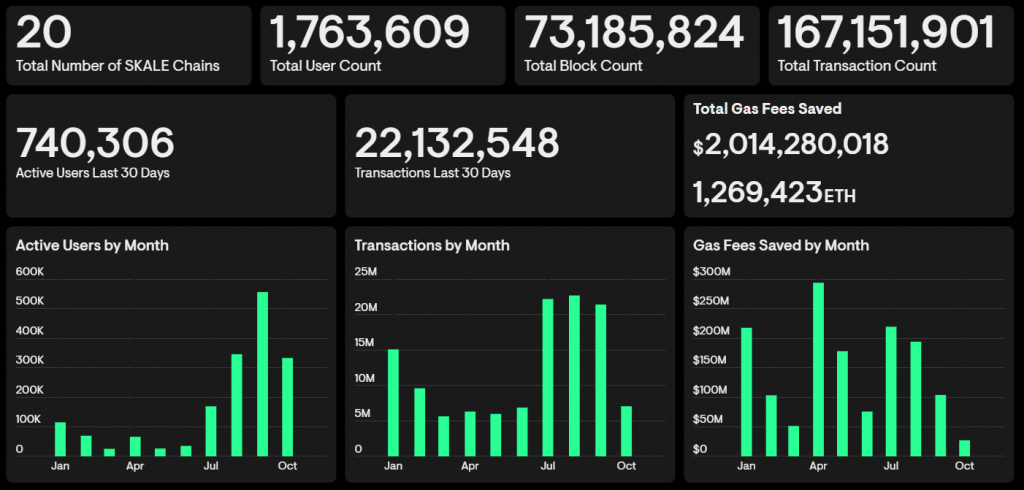SKALE’s new gaming chops

Sign up to our Substack, follow us on Twitter, and connect with us on LinkedIn.
In the latest episode of his Blockchain Gaming World podcast, editor-in-chief Jon Jordan talks to SKALE co-founder Jack O’Holleran about the growth of the Ethereum-based “L2 plus” blockchain, notably its growth as a platform for what O’Holleran calls “high performance dapps” including games such as Untitled Platform, Gamifly and StrayShot.
This transcription has been edited for length and clarity.
BlockchainGamer.biz: So your website says “SKALE is the world’s fastest blockchain”?
Jack O’Holleran: We didn’t say that until Dartmouth Blockchain said it. It did an independent study and onchain live testing. They said it. So now we’ll say it too. We’ve always been more conservative but it’s good to have a third party review.
We’re talking about gaming today and for gaming you can’t mint NFTs into a single wallet and let people use a web2 application. The chain should be interacting and participating. You’ve got to have speed, transaction throughput, low latency time to finality. Those end up being really valuable things for game developers.
How is SKALE different from the other L2s?
I think it’s about horizontal scalability as opposed to just vertical scalability. Vertical scaling is when you need to have a really fast layer on blockchain, or you have something like Ethereum and you stack technology on top of it offchain. Horizontal scaling means you’re adding more resources next to each other and you’re trying to pull security around them.
For example, SKALE has 20 different blockchains that operate with one shared validator set. If these start getting full, there could be a 21st chain and a 22nd, and they start stacking next to each other. But these are also built vertically on top of Ethereum, and Ethereum adds a lot of security.
When we started, people thought we were a bit nuts because there weren’t many people trying this. Polkadot and Cosmos were also trying to grow horizontally with lots of chains, but within the Ethereum ecosystem, we were the only ones with this vision.
Actually, do you call SKALE a L2?
SKALE builds on Ethereum and applications usually launch tokens on Ethereum and then connect to SKALE. In a way we’re like a layer two plus. We’ve got layer one security. We’ve got layer one blockchains that have layer two components and layer two functionality and also some layer two security features. So in a way it’s layer two plus. Some applications put everything onto SKALE, so we’re a layer one for them. We have other applications putting their NFTs on Ethereum, their core token on Ethereum and then connecting to SKALE as the layer two.
The industry is maturing and people are realizing a lot of these nuances don’t matter at the end of the day. Can you help developers? Can you provide fast throughput? Can you write cost-effective transactions and are you secure?
Another issue for most L2s is they post their transactions back to the Ethereum mainnet and so there’s always a cost. Usually it’s five to 10 cents a transaction, but there was a time when because of congestion, Arbitrum had a $4 transaction gas fee and Ethereum’s was $3 for the same thing. SKALE is running consensus in its chain and it’s running really fast and it doesn’t post everything back to Ethereum because it just doesn’t make sense to you from a cost perspective. Last month we had 23 million transactions. Imagine if dapps were spending five or 10 cents per transaction. That wouldn’t be feasible.
How has SKALE grown recently?
Go back three years and the network hadn’t launched but we had big goals and ambitions. Even in June 2022, there were less than a million transactions and probably less than 10,000 active wallets. That’s not even a year and a half ago. Now we’ve had 1.6 million active wallets in total. There’s been 645,000 active wallets in the last 30 days. Last month there were 21.4 million transactions and we’ve had 162 million transactions in total since June 2022. So there’s a lot happening.

Hats off to the developers and the game builders and the people doing growth and community growth at all our partners. Our community and our developers and open source contributors built some really amazing technology, but the ball’s in the hands of the game devs now, and it’s awesome to see them be successful.
What’s it like building in the bear market?
It’s interesting. If you go to DappRadar and just look at the top chains, 85 or 90% of their dapps have zero active wallets. That’s thousands of dapps and there’s nothing happening. But with SKALE and other L2 chains, we’re making progress in the bear market.
When you look at the bear case for blockchain gaming, it’s all about
- “blockchain gaming – the games aren’t fun”
- “It’s expensive to do anything”
- “The user experience is difficult. You have to be an engineer to play”, and
- “It’s just slow, anything that happens onchain is slow”.
Literally all four of those things have been solved. Those criticisms were accurate and fair, but they’re not anymore. A lot of smart people have been working on those problems.
There was blockchain gaming, and then on the other end of the spectrum, there was gaming. And now we’re seeing blockchain games just look like games and feel like games and act like games. When the bear market shifts, people will see that things are happening and promises are being delivered. I think gaming is gonna be the star of the next phase.
Can you highlight some of the successful games on SKALE?
It’s awesome that five of the top 25 games on DappRadar are on SKALE. It’s amazing to see.
We get to see the early indicators of what’s happening so this isn’t a surprise to me because I’ve been seeing these games coming and there’s a lot more coming. It’s exciting to see games like Untitled Platformer and Gamifly – it’s got over a million downloads on the Google Play store and has just gone live on iOS.
There’s StrayShot, which has just launched its public beta. It’s an FPS battle royale game. There’s CryptoCrusades so you get all these different categories.
Do you see SKALE as being a blockchain for gaming?
If we’re being pigeonholed it’s for HPDs, high performance dapps. It’s going to be a huge, growing category. The TAM is going to be massive for high performance applications and the thing is SKALE has chain fees, not gas fees.
Even if you’re using a relayer and you’re subsidizing gas fees on another chain, you can’t touch the unit economics. It’s impossible the way you’re paying for space. You’re paying for compute resource that can run a blockchain up to a certain capacity on SKALE. It’s really difficult to compete with that.
Also, success breeds success. Developers talk to developers. And this is all open source, so there’s people contributing, reading things, testing the code and they don’t even have to talk to us. It’s good to see that kind of flywheel start to operate because that’s how you get scalable growth in a web3 ecosystem.
Earlier you mentioned SKALE alongside Cosmos and Polkadot, which are two chains that don’t have a lot of gaming. Why?
First and foremost, we’re part of the Ethereum community. We love Ethereum. We were at every Ethereum hackathon from 2018 through 2022. Now we’ve shifted to more gaming and web3-focused events but we love Ethereum. We support Ethereum. There’s a rev share. When you use SKALE, Ethereum ends up collecting about 15% of the fees. If you’re building on SKALE, guess what? You’re building on EVM, but you’re also building in this natively-connected ecosystem to Ethereum. That matters for developers. EVM is the winner.
Then I think a big piece is how good can you make your EVM and scale? We have this really fast C++ Ethereum, but we also have a native connection to Ethereum that is a big differentiator across the board. And, you know, it’s just tough. If you’re not in an Ethereum ecosystem, it’s tough. It seemed like people were doing well during the bull market but when you peel back the onion now, you see all the action’s in the Ethereum world.
How do you see the next six to 12 months?
I think we’re going to keep seeing these amazing breakouts. We’re going to quietly get to a point during the bear market where people are saying “There’s 20 million people a day using blockchain applications compared to 10,000 a day back in 2018”.
I made some predictions a while ago when I said there would be an application with one million active users and over 10 million users across the top applications and that’s happening now. I think I was a year late on that one.
Because one of the superpowers of blockchain is that you can bootstrap network effects. People want to be the first to have this token or NFT and then more people start playing. Of course, it will be a little chicken and egg but talk to any core team and everyone is trying to get into position for when the race starts. Hopefully next time, it will be driven by fundamentals and traction, with less bad actors.
You can check out SKALE via its website.
